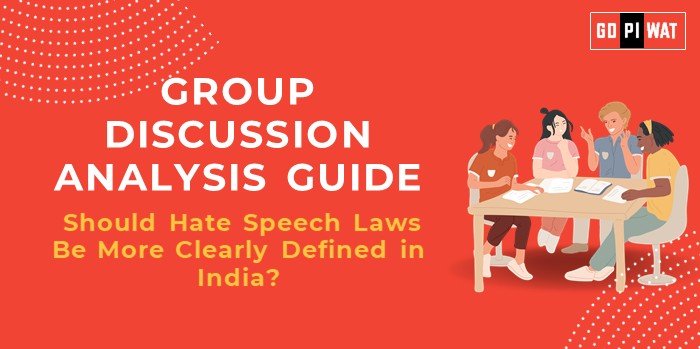📋 Group Discussion Analysis Guide: Should Hate Speech Laws Be More Clearly Defined in India?
🌐 Introduction
Opening Context: The debate on hate speech laws in India is at the intersection of free speech and societal harmony. As a democracy with diverse ethnic, religious, and linguistic groups, defining hate speech poses unique challenges.
Topic Background: While India has laws addressing hate speech under the IPC (e.g., Sections 153A, 295A), their broad language often leads to inconsistent enforcement. This necessitates a discourse on clearer definitions to balance civil liberties and communal peace.
📊 Quick Facts and Key Statistics
- Convictions for Hate Speech: Low, with most cases dismissed due to lack of clarity.
- Social Media Penetration: Over 900 million internet users, amplifying the reach of online hate speech.
- Major Cases: High-profile incidents (e.g., 2020 Delhi riots) linked to inflammatory speeches.
- International Comparisons: Countries like Germany and the UK have clear hate speech laws that include definitions and boundaries.
👥 Stakeholders and Their Roles
- Government: Legislates and enforces hate speech laws.
- Judiciary: Interprets existing laws and ensures constitutional compliance.
- Media: A major disseminator of both free speech and contentious rhetoric.
- Civil Society: Advocates for both stronger hate speech regulations and free speech protections.
✨ Achievements and Challenges
🏆 Achievements:
- Provisions exist to prosecute hate speech, reflecting societal safeguards.
- Legal action taken in several high-profile cases raises awareness.
- Recognition of the issue at global forums, showing India’s commitment to tackling it.
⚠️ Challenges:
- Ambiguity: Terms like “hate” and “offense” are subjective.
- Political Misuse: Allegations of laws being used to silence dissent.
- Digital Spread: Rising online hate speech requires laws tailored to digital platforms.
🌍 Global Comparisons:
- Germany: NetzDG law regulates online hate speech effectively; India lacks a counterpart.
- Case Study (India): Delhi Riots 2020—hate speeches linked to violence.
- Case Study (Global): Germany’s NetzDG Act demonstrates proactive digital hate speech control.
📑 Structured Arguments for Discussion
✅ Supporting Stance:
“Clearer hate speech laws can ensure accountability and protect vulnerable groups from harm.”
❌ Opposing Stance:
“Over-defining hate speech laws could infringe upon free speech and democratic principles.”
⚖️ Balanced Perspective:
“While definitions are crucial, safeguards must be in place to prevent misuse.”
💡 Effective Discussion Approaches
📈 Opening Approaches:
- Use impactful statistics (e.g., internet penetration amplifying hate speech).
- Start with global comparisons (e.g., Germany vs. India).
⚖️ Counter-Argument Handling:
- Reference judicial safeguards like the Supreme Court’s role.
- Propose balance through checks like independent regulatory bodies.
📉 Strategic Analysis of Strengths and Weaknesses
✔️ Strengths:
- Existing laws.
- Judiciary safeguards.
❌ Weaknesses:
- Ambiguity.
- Enforcement gaps.
📈 Opportunities:
- Technology-driven monitoring systems.
⚠️ Threats:
- Risk of misuse for political silencing.
📚 Connecting with B-School Applications
- Real-World Applications: Legal-tech startups could focus on hate speech monitoring.
- Sample Interview Questions:
- “Should free speech have boundaries in a democracy?”
- “Can tech innovation support law enforcement in managing hate speech?”
- Insights for Students: Explore this topic for projects on tech law, societal governance, or digital ethics.


